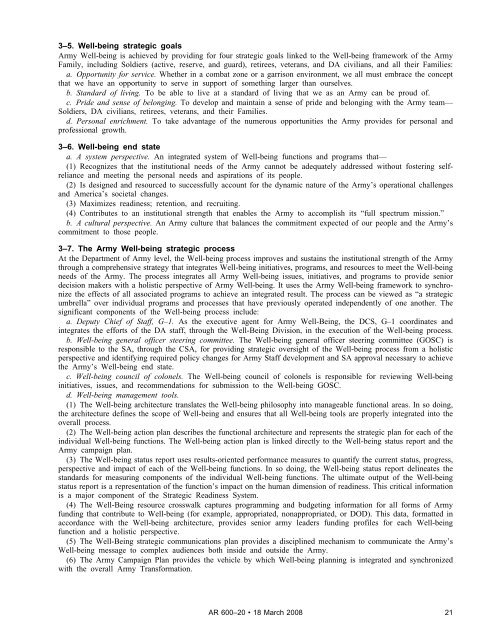AR 600-20, Army Command Policy - Army Publishing Directorate ...
AR 600-20, Army Command Policy - Army Publishing Directorate ...
AR 600-20, Army Command Policy - Army Publishing Directorate ...
You also want an ePaper? Increase the reach of your titles
YUMPU automatically turns print PDFs into web optimized ePapers that Google loves.
3–5. Well-being strategic goals<br />
<strong>Army</strong> Well-being is achieved by providing for four strategic goals linked to the Well-being framework of the <strong>Army</strong><br />
Family, including Soldiers (active, reserve, and guard), retirees, veterans, and DA civilians, and all their Families:<br />
a. Opportunity for service. Whether in a combat zone or a garrison environment, we all must embrace the concept<br />
that we have an opportunity to serve in support of something larger than ourselves.<br />
b. Standard of living. To be able to live at a standard of living that we as an <strong>Army</strong> can be proud of.<br />
c. Pride and sense of belonging. To develop and maintain a sense of pride and belonging with the <strong>Army</strong> team—<br />
Soldiers, DA civilians, retirees, veterans, and their Families.<br />
d. Personal enrichment. To take advantage of the numerous opportunities the <strong>Army</strong> provides for personal and<br />
professional growth.<br />
3–6. Well-being end state<br />
a. A system perspective. An integrated system of Well-being functions and programs that—<br />
(1) Recognizes that the institutional needs of the <strong>Army</strong> cannot be adequately addressed without fostering selfreliance<br />
and meeting the personal needs and aspirations of its people.<br />
(2) Is designed and resourced to successfully account for the dynamic nature of the <strong>Army</strong>’s operational challenges<br />
and America’s societal changes.<br />
(3) Maximizes readiness; retention, and recruiting.<br />
(4) Contributes to an institutional strength that enables the <strong>Army</strong> to accomplish its “full spectrum mission.”<br />
b. A cultural perspective. An <strong>Army</strong> culture that balances the commitment expected of our people and the <strong>Army</strong>’s<br />
commitment to those people.<br />
3–7. The <strong>Army</strong> Well-being strategic process<br />
At the Department of <strong>Army</strong> level, the Well-being process improves and sustains the institutional strength of the <strong>Army</strong><br />
through a comprehensive strategy that integrates Well-being initiatives, programs, and resources to meet the Well-being<br />
needs of the <strong>Army</strong>. The process integrates all <strong>Army</strong> Well-being issues, initiatives, and programs to provide senior<br />
decision makers with a holistic perspective of <strong>Army</strong> Well-being. It uses the <strong>Army</strong> Well-being framework to synchronize<br />
the effects of all associated programs to achieve an integrated result. The process can be viewed as “a strategic<br />
umbrella” over individual programs and processes that have previously operated independently of one another. The<br />
significant components of the Well-being process include:<br />
a. Deputy Chief of Staff, G–1. As the executive agent for <strong>Army</strong> Well-Being, the DCS, G–1 coordinates and<br />
integrates the efforts of the DA staff, through the Well-Being Division, in the execution of the Well-being process.<br />
b. Well-being general officer steering committee. The Well-being general officer steering committee (GOSC) is<br />
responsible to the SA, through the CSA, for providing strategic oversight of the Well-being process from a holistic<br />
perspective and identifying required policy changes for <strong>Army</strong> Staff development and SA approval necessary to achieve<br />
the <strong>Army</strong>’s Well-being end state.<br />
c. Well-being council of colonels. The Well-being council of colonels is responsible for reviewing Well-being<br />
initiatives, issues, and recommendations for submission to the Well-being GOSC.<br />
d. Well-being management tools.<br />
(1) The Well-being architecture translates the Well-being philosophy into manageable functional areas. In so doing,<br />
the architecture defines the scope of Well-being and ensures that all Well-being tools are properly integrated into the<br />
overall process.<br />
(2) The Well-being action plan describes the functional architecture and represents the strategic plan for each of the<br />
individual Well-being functions. The Well-being action plan is linked directly to the Well-being status report and the<br />
<strong>Army</strong> campaign plan.<br />
(3) The Well-being status report uses results-oriented performance measures to quantify the current status, progress,<br />
perspective and impact of each of the Well-being functions. In so doing, the Well-being status report delineates the<br />
standards for measuring components of the individual Well-being functions. The ultimate output of the Well-being<br />
status report is a representation of the function’s impact on the human dimension of readiness. This critical information<br />
is a major component of the Strategic Readiness System.<br />
(4) The Well-Being resource crosswalk captures programming and budgeting information for all forms of <strong>Army</strong><br />
funding that contribute to Well-being (for example, appropriated, nonappropriated, or DOD). This data, formatted in<br />
accordance with the Well-being architecture, provides senior army leaders funding profiles for each Well-being<br />
function and a holistic perspective.<br />
(5) The Well-Being strategic communications plan provides a disciplined mechanism to communicate the <strong>Army</strong>’s<br />
Well-being message to complex audiences both inside and outside the <strong>Army</strong>.<br />
(6) The <strong>Army</strong> Campaign Plan provides the vehicle by which Well-being planning is integrated and synchronized<br />
with the overall <strong>Army</strong> Transformation.<br />
<strong>AR</strong> <strong>600</strong>–<strong>20</strong> 18 March <strong>20</strong>08<br />
21
















